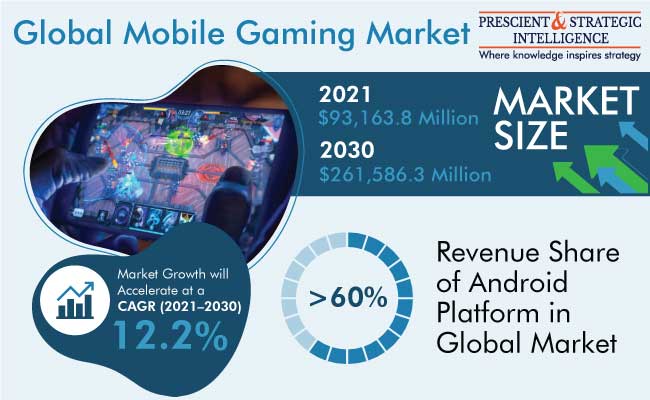How Does Rising Internet Penetration Boost Mobile Gaming Industry?
The mobile gaming industry has garnered $93,163.8 million revenue in 2021, and it is projected to advance at a rate of 12% from 2021 to 2030, to generate $261,586.3 million revenue in 2030. It is ascribed to the rising adoption of innovative technologies for developing games and the increasing usage of smartphones as a crucial contributor to the industry.
In addition, the rising popularity of esports is a major factor in industry growth. The rising usage of the 5G technology provides users with faster data speeds, thus propelling the industry for mobile games. Moreover, the rising disposable income results in increased sales of smartphones thus propelling the number of gamers.
The worldwide gaming industry is rising, and smartphones are playing a major contribution to it. The gaming business has garnered scalability, with the rising advent of mobile games. Platforms such as Instagram and Facebook have resulted in feature mobile games to boost compelling games to propel advertising tactics.
Since worldwide countries are on a heightened alert to curb the spread of COVID-19 and implemented lockdowns as well as stay-at-home orders. There has been a massive demand for digital entertainment, more specifically for digital entertainment demand, especially smartphone games. During this period, the majority of mobile game publishers have experienced massive demand for downloads.
For instance, the WHO recommends citizens stay at home and play games during the lockdown. The gaming campaign #playaparttogether went viral due to the WHO support, and aggressive product development by various gaming companies, more specifically for Activision Blizzard and Glu Mobile.
Cloud gaming transforms the mobile games business by providing better growth options to mobile game providers. Cloud gaming is adopted by various technology companies and cloud gamers. It also reduces the need for memory on smartphones to unlock the game.
In addition, AR facilitates the users to engage with audio and visual information in a more-real setting. VR offers players the first viewpoint and 360-degree vision, keeping one step further, with an immersive real-world experience.
Moreover, the most-popular AR genre in app stores is mobile games, including Ingress and Pokémon Go.
Furthermore, smartphone manufacturers launch gaming phones to provide a better experience to gamers, and thus propels the mobile gaming industry.
In addition, smartphone manufacturers launch gaming phones to provide a better experience to gamers. It thus boosts the global mobile gaming industry.
Google play captures the largest industry share, accounting for more than 60%. The rising sales of smartphones result in an expansion of the Android OS in emerging economies, including Brazil, China, and India, that fuels game downloads through the google play store.
The freemium business model is projected to experience the fastest growth, accounting for over 10% from 2021 to 2030. The additional benefits of developing in-game purchases offered by freemium games propel the industry.
APAC captures a significant share of the industry, led by rising internet access, and rising sales of mobile phones, led by an increasing middle-class population in developing countries, such as India and China.
Therefore, the mobile gaming industry is projected to rise in the coming years, led by worldwide surging sales of mobile phones, and internet penetration.
Read More: https://www.psmarketresearch.c....om/market-analysis/m
